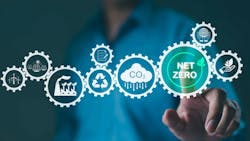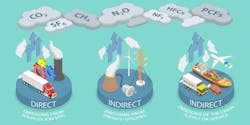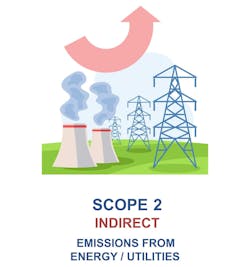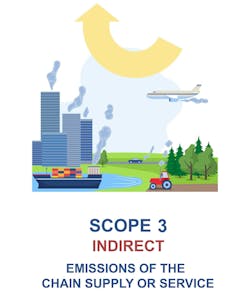What are Scope Emissions and How Can They be Addressed?
In 2001, the World Resources Institute and the World Business Council for Sustainable Development created global standards for measuring greenhouse gas (GHG) emissions known as Scope 1, 2 and 3 emissions.
These three categories were established to help classify the types of GHG emissions produced by companies and aid with setting targets to reduce them. Doing so has become increasingly important to many manufacturers — including those in the fluid power and electromechanical motion control industries as well as their customer markets — who want to be better environmental stewards and help mitigate further warming of the planet.
Scope 1 Emissions
Scope 1 emissions are those which are produced by a company at its own facilities such as GHG created by burning oil or gas to heat a building.
What are Greenhouse Gas Emissions?
Greenhouse gases are those such as carbon dioxide (CO2), methane (CH4) and nitrous oxide (N20) which are released into the atmosphere and trap heat, causing the earth to get warmer. Various human activities are considered to be the leading producer of GHG emissions, such as burning fossil fuels for electricity and transportation.
Transportation and industry are among the top producers of GHG which is why there are so many efforts to reduce emissions from these sectors.
ISN, a provider of contractor and supplier information management tools, recently collected data from contractors and suppliers in a range of industries — including construction, manufacturing, mining and more — to gauge how they are addressing their Environmental, Social & Governance (ESG) goals. In terms of the environment, ISN’s analysis showed 16% of companies have strategies in place to reduce GHG and nearly 18% are calculating and reporting both Scope 1 & 2 Emissions data.
To reduce these emissions, many companies are employing more efficient technologies to reduce energy use which leads to fewer emissions produced. This can include installing newer, more energy-efficient equipment in a facility or updating company fleets to electric or other alternatively powered vehicles.
In late 2023, battery charging technology developer Delta-Q Technologies announced it achieved the goals of its Scope 1 and 2 emissions reduction targets. To meet its Scope 1 targets, the company built a new global headquarters equipped with technologies designed to meet the company’s net-zero emissions goals.
Electric heat pumps, ultra-efficient LED lighting, smart building controls and enhanced insulation are used in the new building to reduce energy consumption. In addition, the company said in its press release announcing it achieved its emissions reduction targets that it no longer consumes fossil fuels for heating or powering any systems in its new headquarters. This results in zero direct carbon emissions the company said.
Scope 2 Emissions
Scope 2 deals with indirect emissions related to the purchase of electricity, steam, heat or cooling. Because they have to do with a company’s energy use, and ability to potentially reduce that or use alternative sources, they are included in the scope emissions.
To mitigate these types of emissions, many companies are turning to alternatives to fossil-based energy sources such as solar panels and wind turbines. Delta-Q Technologies for instance, is using energy supplied by a hydroelectric grid to power all systems at its new headquarters which has enabled it to achieve near-zero emissions.
By utilizing less energy and reducing dependance upon fossil-based sources like coal and gas, demand for these products can be lowered as well as the emissions associated with producing and using them.
In 2022, Danfoss’ largest production facility located in Nordborg, Denmark became carbon neutral. The 250,000 m2 facility was able to do so by reducing its energy consumption, reusing excess heat from processes and data centers as well as purchasing green electricity – that which is produced from renewable energy sources such as solar and wind.
Five additional factories became carbon neutral at the end of 2023, with more set to do the same in the coming years. Like many companies, Danfoss has set ambitious emissions reduction targets; it has committed to reducing 46.2% of its absolute Scope 1 and 2 emissions by 2030 which it aims to achieve through steps like decarbonizing its production facilities.
In line with these efforts, Danfoss announced in 2023 its plans to power all of its facilities in North America with solar energy by 2025. It believes doing so will help reduce the company’s carbon footprint in North America by 75%. Danfoss also plans to reduce and reuse energy in these facilities by utilizing oil-free, variable speed compressors and other technologies that can recover heat and improve energy efficiency.
READ MORE: The Differences Between Oil-Free and Oil-Lubricated Air Compressors
Scope 3 Emissions
Scope 3 covers all other indirect emissions sources such as those associated with materials purchased and utilized by a company. The U.S. Environmental Protection Agency (EPA) said Scope 3 emissions are also referred to as value chain emissions and include those which are produced both upstream and downstream of an organization’s activities.
These are considered more difficult to address because they encompass so many aspects and can be difficult to measure. The Greenhouse Gas Protocol, which established the scope emissions, defines 15 categories under Scope 3 including:
- purchased goods and services
- upstream transportation and distribution
- waste generated in operations
- employee commuting
- use of sold products.
However, this does not mean companies are not doing what they can to address this category of emissions. Delta-Q Technologies said that after addressing its Scope 1 and 2 emissions targets, it is now focusing on reducing its Scope 3 emissions. It stated in its press release that it will do so by collaborating with and educating partners across its value chain.
Danfoss has set a target of reducing its value chain emissions (i.e., Scope 3) 15% by 2030 as part of its corporate decarbonization efforts. To aid with this, it will increase its use of low-carbon aluminum.
In late 2023, the company announced it had joined the aluminum sector of the First Movers Coalition (FMC), a global coalition to decarbonize hard-to-abate industries including aluminum, aviation, chemicals, concrete, shipping, steel and trucking, which are responsible for 30% of global emissions.
As part of the coalition, Danfoss commits to at least 10% (by volume) of all the company’s primary aluminum procured per year being low carbon by 2030 while also ensuring that at least 50% of all aluminum used annually is composed of secondary aluminum by 2030.
By having large, global companies like Danfoss join FMC and commit to using low-carbon options, it demonstrates the feasibility of these solutions and will hopefully aid their continued market uptake to help bring down costs and emissions.
Through these and many other initiatives, companies are working to reduce their environmental impact as well as that of their customers. While the environmental aspect is important, it is also providing business opportunities for many by lowering operational costs due to the use of more energy efficient solutions and prompting new technological developments to aid global decarbonization.
How are Emissions Reduction Efforts Trending?
On September 20, the California Air Resources Board (CARB) released a report showing greenhouse gas emissions (GHG) have declined in the state without negatively impacting its economy.
The report on 2022 GHG emissions shows declines in most sectors, with transportation recording the largest drop in emissions due to increased use of renewable fuels and zero-emissions vehicles. Emissions declined in five of the seven sectors tracked in the report, reducing total emissions in California by 9.3 million metric tons.
CARB stated in a press release announcing the new report that between 2000 and 2022, emissions fell by 20% while California’s gross domestic product increased by 78%. “The numbers are clear: our world-leading regulations are reducing emissions, spurring innovation, and bringing us closer to achieving our climate goals,” said CARB Chair Liane Randolph. “A future with clean air and a vibrant economy is possible.”
About the Author
Sara Jensen
Executive Editor, Power & Motion
Sara Jensen is executive editor of Power & Motion, directing expanded coverage into the modern fluid power space, as well as mechatronic and smart technologies. She has over 15 years of publishing experience. Prior to Power & Motion she spent 11 years with a trade publication for engineers of heavy-duty equipment, the last 3 of which were as the editor and brand lead. Over the course of her time in the B2B industry, Sara has gained an extensive knowledge of various heavy-duty equipment industries — including construction, agriculture, mining and on-road trucks —along with the systems and market trends which impact them such as fluid power and electronic motion control technologies.
You can follow Sara and Power & Motion via the following social media handles:
X (formerly Twitter): @TechnlgyEditor and @PowerMotionTech
LinkedIn: @SaraJensen and @Power&Motion
Facebook: @PowerMotionTech

Leaders relevant to this article:




